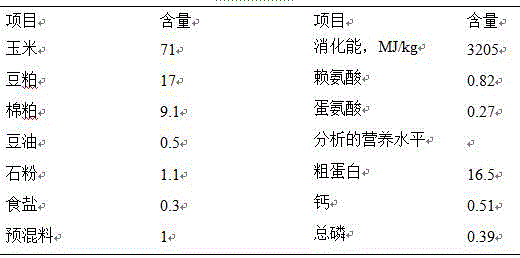Compound feed additive capable of reducing swine manure odor and application thereof
A compound additive and odor technology, applied in applications, animal feed, animal feed, etc., can solve problems such as high odor, excessive nitrate content in groundwater, and feces pollution, and achieve reduced elimination, improved digestion and absorption, and reduced The Effect of Fecal Odor Pollution Status
- Summary
- Abstract
- Description
- Claims
- Application Information
AI Technical Summary
Problems solved by technology
Method used
Image
Examples
Embodiment 1
[0046] (1) Bacillus subtilis (strain preservation number CGMCC 1.504) was cultured in LB liquid medium for 18 h, and the colony density reached 1×10 11 CFU / mL, add appropriate amount of bran after drying and concentrating (the weight ratio of bacteria solution and bran is 1:100), the concentration of Bacillus subtilis in the final product is 1×10 12 CFU / g. The prepared Bacillus subtilis had the same physicochemical properties as described.
[0047] The LB liquid medium refers to weighing 10 g of tryptone, 5 g of yeast extract, and 5 g of sodium chloride, adding about 800 mL of deionized water, and stirring well. Adjust the pH value to 7.0 with sodium hydroxide, add deionized water to make up to 1 L, and sterilize at 121°C for 20 minutes.
[0048] (2) The preparation method of Yucca plant extract:
[0049] Yucca plants refer to Yucca schidigera (Yucca schidigera) harvested, cut into small pieces and then mechanically crushed into fibers, soaked in clean water, the ratio of...
Embodiment 2
[0052] 20 growing pigs weighing 40 kg were selected and divided into two treatments, each with 10 pigs. The pigs in the control group were fed with the basic diet, and the pigs in the experimental group were fed with 5×10 5 CFU / g Bacillus subtilis, 80 g / ton Yucca plant extract. The test period was 20 days, and feces were collected once every 10 days, and the content of 3-methylindole was measured therein. The results of the measurement are shown in Table 4. Wherein the weight and number ratio of Bacillus subtilis and Yucca genus extract is 1:7;
[0053] Table 4 Effects of different dietary treatments on the content of 3-methylindole in pig manure, ng / g
[0054]
Embodiment 3
[0056] 20 fattening pigs weighing 60 kg were selected and divided into two treatments, each with 10 pigs. The pigs in the control group were fed with the basic diet, and the pigs in the experimental group were fed with 5×10 8 CFU / g Bacillus subtilis, 60 g / ton Yucca plant extract. The test period was 20 days, and feces were collected once every 10 days, and the content of 3-methylindole was measured therein. The results of the measurement are shown in Table 5. Wherein the weight and number ratio of Bacillus subtilis and Yucca genus extract is 1:7;
[0057] Table 5 Effects of different dietary treatments on the content of 3-methylindole in pig manure, ng / g
[0058]
PUM
 Login to View More
Login to View More Abstract
Description
Claims
Application Information
 Login to View More
Login to View More - R&D Engineer
- R&D Manager
- IP Professional
- Industry Leading Data Capabilities
- Powerful AI technology
- Patent DNA Extraction
Browse by: Latest US Patents, China's latest patents, Technical Efficacy Thesaurus, Application Domain, Technology Topic, Popular Technical Reports.
© 2024 PatSnap. All rights reserved.Legal|Privacy policy|Modern Slavery Act Transparency Statement|Sitemap|About US| Contact US: help@patsnap.com










